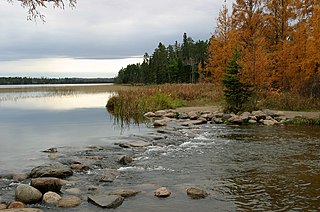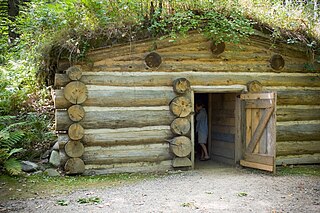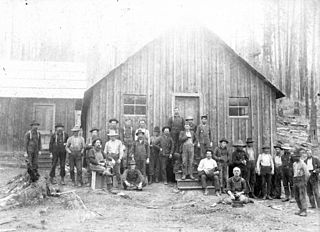
A cowboy is an animal herder who tends cattle on ranches in North America, traditionally on horseback, and often performs a multitude of other ranch-related tasks. The historic American cowboy of the late 19th century arose from the vaquero traditions of northern Mexico and became a figure of special significance and legend. A subtype, called a wrangler, specifically tends the horses used to work cattle. In addition to ranch work, some cowboys work for or participate in rodeos. Cowgirls, first defined as such in the late 19th century, had a less-well documented historical role, but in the modern world work at identical tasks and have obtained considerable respect for their achievements. Cattle handlers in many other parts of the world, particularly South America and Australia, perform work similar to the cowboy.

Itasca State Park is a state park of Minnesota, United States, and contains the headwaters of the Mississippi River. The park spans 32,690 acres (132.3 km2) of northern Minnesota, and is located about 21 miles (34 km) north of Park Rapids, Minnesota and 25 miles (40 km) from Bagley, Minnesota. The park is part of Minnesota's Pine Moraines and Outwash Plains Ecological Subsection and is contained within Clearwater, Hubbard, and Becker counties.

All Stretton is a village and a now separate civil parish in Shropshire, England. Much of it is covered by a Conservation Area.

Hostelling Scotland is part of Hostelling International and provides youth hostel accommodation in Scotland. As of January 2022 the organisation represents 58 hostels: 31 run by Hostelling Scotland and 27 affiliates.

Flandrau State Park is a state park of Minnesota, United States, on the Cottonwood River adjacent to the city of New Ulm. Initially called Cottonwood River State Park, it was renamed in 1945 to honor Charles Eugene Flandrau, a leading citizen of early Minnesota who commanded defenses during the Battles of New Ulm in the Dakota War of 1862. The park was originally developed in the 1930s as a job creation project to provide a recreational reservoir. However the dam was repeatedly damaged by floods and was removed in 1995.
Texas Ranch House is an PBS American reality television series that premiered in May 2006. Produced by Thirteen/WNET New York, Wall to Wall Media Limited, and PBS, the show placed fifteen modern day people in the context of 1867 Texas. Show participants attempted to run a ranch for two and a-half months using 19th century tools and techniques.

Cowboy U was an American reality television series that aired on CMT from 2003 to 2007. The show premiered on August 29, 2003. Each season, eight "city slickers" were brought to a ranch and competed to win the final rodeo and $25,000.

The Spade Ranch is a large cattle ranch located in the Sandhills of western Nebraska between the towns of Gordon and Ellsworth. Founded in 1888 by Bartlett Richards, the ranch was placed on the National Register of Historic Places in 1980.

The Double Diamond Dude Ranch Dining Hall was built in 1945 as the centerpiece of a dude ranch operated by Frank Williams and Joseph S. Clark, Jr. in Grand Teton National Park. The ranch was opened in 1924 with a dozen tent cabins and log buildings for a kitchen and dining hall, lounge and commissary. In 1943 Williams built log tourist cabins, followed by the larger dining hall in 1945. The 1985 Taggart Lake Fire destroyed much of the ranch, sparing only the dining hall and five cabins. The dining hall is listed on the National Register of Historic Places as an example of rustic architecture. Since 1970 the Double Diamond property has been a hostel for mountain climbers in the Teton Range, and is known as the Climbers' Ranch.

The Hunter Hereford Ranch was first homesteaded in 1909 by James Williams in the eastern portion of Jackson Hole, in what would become Grand Teton National Park. By the 1940s it was developed as a hobby ranch by William and Eileen Hunter and their foreman John Anderson. With its rustic log buildings it was used as the shooting location for the movie The Wild Country, while one structure with a stone fireplace was used in the 1963 movie Spencer's Mountain. The ranch is located on the extreme eastern edge of Jackson Hole under Shadow Mountain. It is unusual in having some areas of sagebrush-free pasture.

The Faraway Ranch Historic District is part of the Chiricahua National Monument in southern Arizona, and preserves an area associated with the final conflicts with the local Apache, one of the last frontier settlements, and in particular, its association with the people who promoted the establishment of the Chiricahua National Monument. Faraway Ranch is located in Bonita Canyon, which lies at an approximate altitude of 5160 feet and opens in a southwesterly direction into the Sulphur Springs Valley.

The Riddle Brothers Ranch is a pioneer ranch complex located in the Steens Mountain Cooperative Management and Protection Area in Harney County in eastern Oregon, United States. It is a rare extant example of the small family ranch. The ranch is located on both sides of the Little Blitzen River on public land and is administered by the Bureau of Land Management.

The Youth Hostels Association of India (YHAI) is an organisation providing youth hostel accommodation in India. It is a member of the Hostelling International federation.

The Forest History Center is part of the Minnesota Historical Society's network of historic sites and museums. Located in Grand Rapids, Itasca County, Minnesota, on wooded acreage adjoining the Mississippi River, the Forest History Center provides learning experiences about the forests, logging industry, and forest conservation. The historical and changing relationship between the people and the forest is displayed through exhibits and films, demonstrations, a living history lumber camp, an original 1934 fire tower, and nature trails. The Forest History Center has regular special events, and offers various programs for school field trips.

The David L. Shirk Ranch is a historic ranch located in the Guano Valley of eastern Lake County, Oregon, United States. The ranch was originally homesteaded in 1881. It was purchased by David L. Shirk in 1883. He operated the ranch until 1914. The property was acquired by the United States Government in 1942. The ranch is now administered by the Bureau of Land Management. The remaining historic ranch buildings are listed on the National Register of Historic Places.

The F.S. King Brothers Ranch Historical District is located in the hills northeast of Laramie, Wyoming.

The CM Ranch and Simpson Lake Cabins are separate components of a single historic district associated with Charles Cornell Moore, a Fremont County, Wyoming dude ranch operator. The CM ranch, named after Moore, operated as a dude ranch from 1920 to 1942 and resumed operating in 1945. The Simpson Lake Cabins were purchased by Moore in 1931 and were operated as a hunting camp, continuing until 1997 when the CM ranch was sold to new owners and the Simpson Lake property was taken over by the U.S. Forest Service.. The sites are separated by 13 miles (21 km).

The Cross River Heritage Center is a museum in Schroeder, Minnesota, United States. Operated by the Schroeder Area Historical Society, it collects and interprets the history of the local area and the greater North Shore of Lake Superior. The center opened in 2002 in a Tudor Revival building constructed in 1929 as the Stickney Inn and Store. The building is located on the south side of Minnesota State Highway 61 near the west bank of the Cross River.

A logging camp is a transitory work site used in the logging industry. Before the second half of the 20th century, these camps were the primary place where lumberjacks would live and work to fell trees in a particular area. Many place names are legacies of old logging camps. Camps were often placed next to river tributaries so that the winter's log harvest could be floated to the lumbermills in the spring.

A cookhouse is a small building where cooking takes place. Often found at remote work camps, they complemented the bunkhouse and were usually found on ranches that employed cowboys, or loggers in a logging camp. Prior to the 20th century, cookhouses were a feature of some private residences where the kitchen was a separate building so the heat and smoke from cooking was kept away from the main residential building.




















